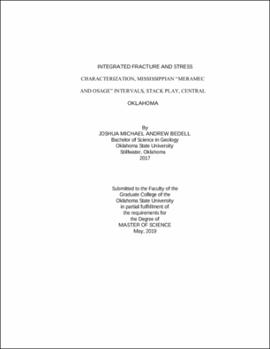| dc.contributor.advisor | Ismail, Ahmed | |
| dc.contributor.author | Bedell, Joshua Michael Andrew | |
| dc.date.accessioned | 2021-10-21T15:52:06Z | |
| dc.date.available | 2021-10-21T15:52:06Z | |
| dc.date.issued | 2019-05 | |
| dc.identifier.uri | https://hdl.handle.net/11244/331151 | |
| dc.description.abstract | Characterization of fractures, paleo-stresses, and the in-situ stress state is a major topic of interest among geoscientists and engineers in the petroleum industry. Fractures can significantly influence reservoir quality, while both fractures and the stress-fields impact all phases of hydrocarbon exploration and development. Years of study have resulted in dozens of different techniques to detect and characterize fractures and stresses, and their ensuing impact on reservoir quality. However, integrated fracture characterization studies are rarely implemented into exploration projects due to lack of essential datasets, budgets, and time constraints, which in many cases, negatively impact subsequent exploration and development strategies. Previous studies over the STACK play in central Oklahoma have indicated that naturally fractured zones may have a potential impact on production within the "Meramec and Osage" intervals. Therefore, this study aimed to characterize fracture density and orientation, and stress-regimes within the "Meramec and Osage" intervals in the STACK play through an integrated approach. This approach is based on the analysis of 3D seismic data, petrophysical data from six wells, two cores and one Formation Micro-Imaging (FMI) log. Density and orientation of seismic-scale fractures were estimated based on a generated suite of seismic attributes and a discrete fracture network. Density of log-scale fractures was inferred from the analysis of the petrophysical, cores, and FMI log data, while orientations of these fractures were determined only from the FMI log. Both modern and ancient stress regimes were estimated from the analyses of the seismic and the FMI log data. Orientations of the natural fractures and drilling induced fractures were used to estimate the in-situ and paleo-stress-fields. Although the scale of fractures detected by each of the four datasets was different, density and orientations of the different-scale interpreted fractures were consistent. Additionally, fractures were shown to have an overall negative impact on the "Meramec's" reservoir quality but had a positive influence on reservoir quality in the "Osage" interval. The results of this study showed that the integrated approach of fracture characterization utilizing multi-scale datasets can better improve our understanding of fractures and the early and contemporary stress states of the reservoir, thereby reducing risk associated with petroleum exploration, drilling, and completion activities. | |
| dc.format | application/pdf | |
| dc.language | en_US | |
| dc.rights | Copyright is held by the author who has granted the Oklahoma State University Library the non-exclusive right to share this material in its institutional repository. Contact Digital Library Services at lib-dls@okstate.edu or 405-744-9161 for the permission policy on the use, reproduction or distribution of this material. | |
| dc.title | Integrated fracture and stress characterization, Mississippian "Meramec and Osage" intervals, STACK play, central Oklahoma | |
| dc.contributor.committeeMember | Puckette, James | |
| dc.contributor.committeeMember | Grammer, Michael | |
| osu.filename | Bedell_okstate_0664M_16240.pdf | |
| osu.accesstype | Open Access | |
| dc.type.genre | Thesis | |
| dc.type.material | Text | |
| dc.subject.keywords | fractures | |
| dc.subject.keywords | meramec | |
| dc.subject.keywords | osage | |
| dc.subject.keywords | paleo-stress | |
| dc.subject.keywords | stack | |
| dc.subject.keywords | stress | |
| thesis.degree.discipline | Geology | |
| thesis.degree.grantor | Oklahoma State University | |
